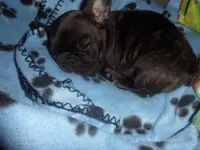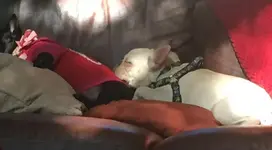Here is an example of how to do slow introductions

:
FBRN Slow Intro Policy
This policy is to be followed by all FBRN foster homes and adoptive homes.
Issues often develop when you provide a new dog with "too much too soon." This can create
many behavior problems that can take months of counterconditioning to undo. So, it is very
worthwhile to spend a little bit of time setting the ground rules at the outset. In the long run, it
will be better for you, the new dog and your pack.
Take everything SLOW when bringing a new dog into to your home. It is easier to take it
slow, than to bring a new dog into your pack and deal with the problems that arise from not
implementing slow introductions. Your pack may be one dog or several dogs. The more
dogs in your pack, the longer the process takes. This process is also required for homes
with no dogs in residence, but who have other pets, especially cats.
Be prepared. Designate a quiet room for the new dog. You will need a crate, baby gate,
blanket and leash.
Week 1
Even with dogs that are supposedly good with other dogs, start the first week with the new
dog in a separate room and having no direct interaction with your dogs. If you do not have
the ability to separate in a separate room, put up a baby gate with a blanket draped over it
so the dogs cannot see each other. Your dogs will know that there is a dog in that room, and
the new dog will know your dogs are there. This gives the new dog time to relax and
acclimate by taking in the new smells and sounds. The new dog will be less stimulated and
typically less reactive in the long run when given the time to be introduced to the new pack
by sound and scent first, and later by sight. This will also help the new dog understand that
the other animals in your home are valuable members of your pack and important to you.
Please ensure the dogs are also separated during potty breaks.
Week 2
Put up a baby gate to separate the new dog from your dogs. Drape a blanket over half of it.
Your dogs can take turns looking and smelling, and it gives the new dog the ability to hide
and be non-confrontational. If the new dog is nasty at the baby gate, stand there with a
short leash and be ready to correct him. Try this again and again until there is no reaction at
the baby gate. PATIENCE. Remove the blanket so the entire baby gate is visible to
everyone. See how that goes.
Once all dogs are able to be calm through the gate, you may start introductions. A walk on
neutral territory is the best way to introduce new dogs. Begin with the new dog and your
least reactive dog. You should have a second person, if possible, to assist with this. Each
person will control the leash of one dog. Begin a good distance from each other; slowly and
calmly bring the dogs closer as you progress. Parallel leash walking on neutral territory with
two handlers is a great way to introduce dogs. Neutral territory means an area where neither
dog has been or where neither dog resides. If both dogs are relaxed, allow them to greet
each other. Avoid face-face, head-on introductions between dogs. Instead, walk parallel to
each other, a few feet apart and alternate which dog is ahead of the other. Also, do not allow
a dog to greet another dog if he is dragging you towards the other dog or is misbehaving in
any way (pulling, jumping or lunging). Doing so will result in training the dog to misbehave to
gain access to other dogs!! If there is any tension, keep moving. It may take several walks
before the dogs are ready to interact. If the new dog is reactive to large dogs, introduce him
to a small dog first or vice versa. Only add ONE dog to the mix at a time. IF there is going to
be a fight, it is much easier to separate two dogs than numerous dogs.
This phase may take weeks. PATIENCE. After four weeks of consistent corrections and
discipline for naughty behaviors, the new dog should be integrated with your pack. Some
dogs will move into your pack quicker and some slower. You need to base it on each dog’s
behaviors. Always err on the side of caution, and take things slow. No need to rush things!
ALWAYS ALWAYS, keep a short leash on the new dog and allow him to drag it around for
the first 4 weeks. Don't EVER feel bad and take the leash off; just as soon as you do, you
will have a dogfight and no handle to separate them. NEVER leave the new dog
unsupervised with your dogs. Crate or separate them while you can't supervise. If you have
already had a dogfight, NEVER leave the dogs together, not even for 10 minutes while you
are in the shower. This sounds like a lot of work, but if you are not there to watch and stop
the behavior before the fight, it can escalate to a dangerous situation before you can get
there to split it up.
Please allow the dog to acclimate to your home before introducing him to new people or
taking him out, with the exception of a trip to the vet. A trip to Petsmart or a large family
gathering will provide too much stimulation.
Experienced volunteers have developed this method over years of trial and error.
Sometimes, no matter how hard you try, you may still have the occasional fight. It
happens. But, by following these simple rules, they will be minimal.
When you have a leash on the dog and you see the "stink eye," REMOVE the dog from the
situation immediately. Take the dog by the leash, and put him in the bathroom for 30
seconds of silence. Any longer than 30 seconds and the dog will “forget” that it was
ostracized from the pack and the lesson will have no value. Ostracizing a dog from a pack is
a powerful tool. The key word is "silence," NO whining or scratching allowed. You can run
the leash under the door to allow you to correct the dog for whining or scratching. When you
let the dog out, be sure he has a better attitude and is paying attention to you. Repeat this
as many times as needed EVERY time you see him giving the stink eye, stalking or
displaying naughty behaviors. If a dog fight does happen, it is often necessary to go back to
step one for a few days. Sometimes, dogs not separated for a few hours/days after a fight
can escalate their behavior. Be consistent and strong.























